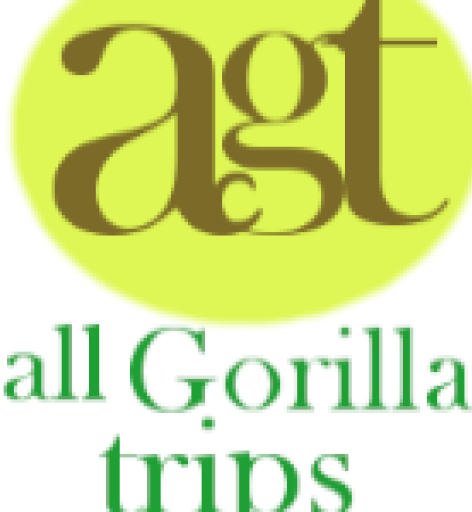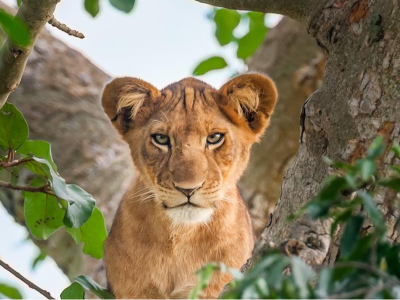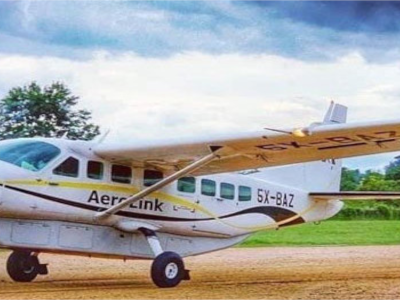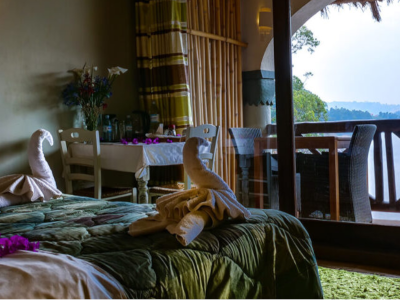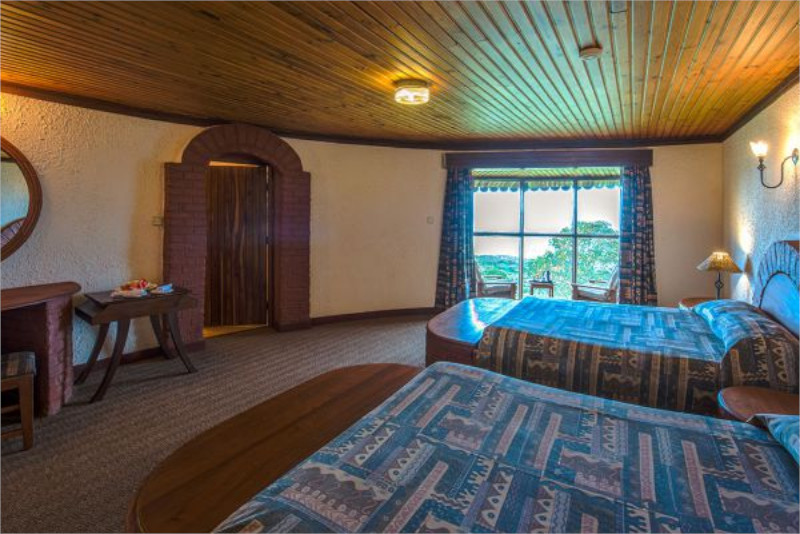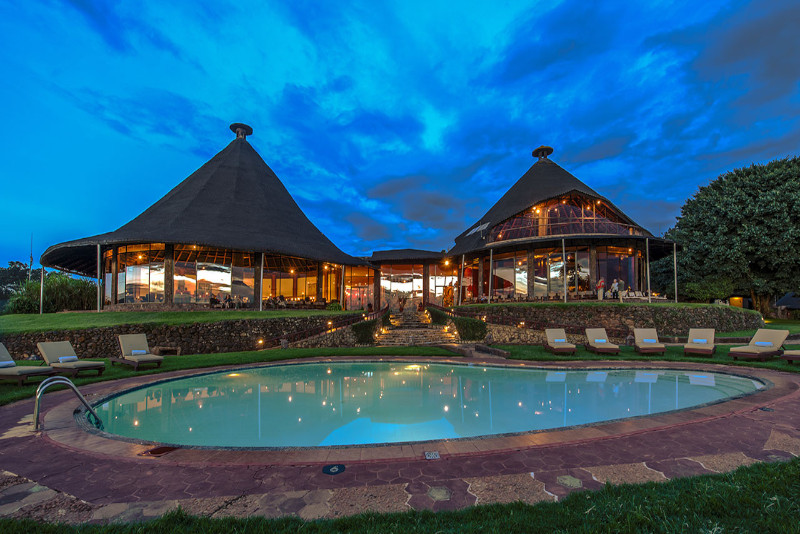Ngorongoro Sopa Lodge
Ngorongoro Sopa Lodge
Facing the always magnificent sunsets to the west, and located at the highest point on Ngorongoro crater’s entire rim, Ngorongoro Sopa Lodge stands well over half a kilometer above the crater floor and offers unparalleled views across this enormous caldera.
The lodge is themed with traditional circular African houses with conical roofs decorated with examples of Africa’s rich tapestry of artistic traditions with rich woodcarvings and sculptures, allowing the lodge to harmonize perfectly with its dramatic surrounding. The lodge has 97 rooms set in a large two-story rondavel, separate from the main building. Each rondavel has four bedrooms, two downstairs and two upstairs with a perfect view of the crater.
Room facilities
- Dressing table, a stool and a hair drier.
- Bathrobe and slippers
- Mineral water and Toiletries
- Direct dial telephone and WIF
- Children’s meals, beds, babysitting
- Laundry, valet, and shoeshine services
Amenities
- Curio shop
- Dining Room
- Spa
- Lounge bar
- Swimming Pool
Activities
- Game drive at the crater
- Nature Walks
- Massage Services
- Sundowners on the Crater Rim
The Ngorongoro Crater, Tanzania Safaris
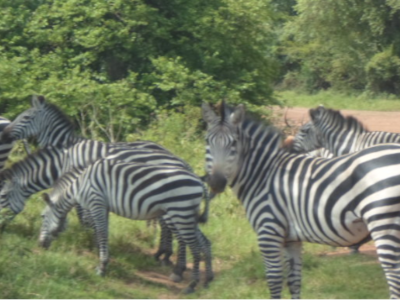
The Ngorongoro Crater, Tanzania Safaris
The Ngorongoro Crater, the world's largest intact volcanic caldera, holds Africa’s Big Five in the continent's most dramatic setting. Fantastic cats, as well as huge tusker elephants and a large population of black rhino, are the major highlights.
Located in northern Tanzania, the Ngorongoro Crater is one of Africa’s most famous parks. Two to three million years ago, this ancient volcano, supposedly as high as Kilimanjaro, imploded, leaving the world’s largest intact caldera, complete with 600m-high walls. Over the years, the fertility of the volcanic soil and year-round water supply has attracted one of the highest concentrations of game in Africa. Today, Ngorongoro is a truly stunning site and has some of the best of anywhere we operate safaris. Where else can you go on safari in an extinct volcano packed with the Big Five?!
Can I see the Big Five in Ngorongoro Crater?
The Ngorongoro Crater is one of the best places in Africa to see the Big Five (buffalo, lion, leopard, elephant and rhino). With approximately 70 lion, huge buffalo herds, 40 rhino and some of the largest tusker elephants left in Africa today, the only somewhat tricky Big Five sighting is leopard. As elusive as ever, nevertheless leopards can be found in the Lerai Forest and even seen openly on the Crater rim. As the Crater has 600m-high walls on all sides, it has created its own self-contained ecosystem. The vast majority of animals live in the Ngorongoro throughout the year, choosing not to migrate but to rely on the Crater’s remarkably fertile grazing grounds and water supply. As a result, game viewing is reliably brilliant throughout the year.
General game viewing experience
With its sprawling plains, soda lake and acacia woodland, it is well able to support a wealth of wildlife. For good reason, it is known as ‘the garden of Eden’ and ‘the cradle of life’! Cats that roam the Crater floor include plentiful prides of lion and leopard as mentioned, benefiting from the influx into the area of wildebeest, Burchell’s zebra and further game species throughout the winter months. In fact, the Crater boasts the highest density of lion worldwide!
As mentioned above, leopard like to spend their days around the rim and can often be seen around the Lerai Forest. Cheetah numbers are very low, but the small population can often be sighted. The real prizes for cat lovers, however, are serval, caracal and golden cat. The last two are very rarely in evidence, but serval are often seen on game drives.
In addition to wildebeest and zebra, the Crater is home to black rhino, Grant’s and Thomson’s gazelles, eland, topi, spotted hyena, hartebeest, jackal, black-faced vervet, baboon and warthog! The lake and its tributaries attract hippopotamus, waterbuck and many other species, while the higher regions are populated by mountain reedbuck, Cape buffalo and elephant. The elephant numbers are not overwhelming, but some of the oldest and largest tuskers have taken up residency here. With tusks hitting the floor, it is well worth looking out for these exceptional creatures.
The birdlife is excellent in the Crater, with over 200 species to keep avid birdwatchers busy! A particularly spectacular sight is the congregation of vast numbers of common and dwarf flamingo in the Crater’s soda lake, feasting upon crustaceans and algae. The area has many raptors, such as marsh harrier, augur buzzard, black kite, tawny eagle and white-backed vulture. Other feathered beauties comprise avocet, hoopoe, black-bellied bustard, cattle egret, ostrich, fan-tailed widow-bird, grey-rumped swallow, little grebe, red-billed firefinch, speckled pigeon and wattled starling. Make sure you pack your binoculars!
A brief history of the Ngorongoro Conservation Area
In 1959, the Conservation Area including Ngorongoro Crater received protection under the Ngorongoro Conservation Area Ordinance. The site was allocated for multiple use and wildlife roamed the floor adjacent to the livestock of the semi-nomadic Maasai farmers. To this day, protection continues under the Ordinance, with the Ngorongoro Conservation Area Authority in charge of wildlife conservation. Its concerns include measures to prevent poaching, monitoring of invasive species, management of tourism and infrastructure control.
The Ngorongoro Crater is only a part of a much larger eco-system – the Ngorongoro Conservation Area. The magical Crater is obviously the major attraction, but the Conservation Area is also home to off-the-beaten-track areas such as Empakai Crater (a smaller and water-filled Ngorongoro) and the forests that lead towards the active volcano of Oldoinyo Lengai (see our Lake Natron page for this remarkable area). These remote areas are without doubt among Tanzania’s hidden gems.
When to go to see game?
Due to the massive concentrations of loads of species you are guaranteed a wonderful show at any time of year. Mainly due to the fact that the animals here do not leave the Crater floor, you can have outstanding game drives at any time of year. The only problem with Ngorongoro is how busy the park can become, which has an adverse effect on the quality of game viewing on offer. July and August are incredibly busy months, as is Christmas and much of February. But the reality of Ngorongoro is that game viewing should be seen as a bonus – it is the sheer beauty of being on safari in an extinct volcano that should be your reason to travel here.
Activities in the Ngorongoro Crater
Activities in the Ngorongoro Crater are limited to game drives only. Walking safari as well as night safari is not permitted. There are picnic areas on the Crater floor, but the main activity is daytime game driving. There are lodges on the Crater rim that offer short walks, but you have to move farther afield into the Ngorongoro Conservation Area to find any proper walking areas or villages to visit.
The accommodations off the Crater rim (in nearby Karatu especially) can offer a significantly wider diversity of activities. Here lodges have access to the village of Mto wa Mbu, where Maasai villages are open for visits, walking areas are endless, and there is a real buzz of tribal life. The properties here can also offer game drives in Lake Manyara or up and down the Great Rift Valley. Horse riding is an option from some of these properties.
Where to stay in the Ngorongoro Crater
With regard to accommodation in this area, you have two options. You can either stay on the Crater rim itself or you can stay in one of the boutique properties in the surrounding highlands. Generally we would not recommend the majority of camps located on the Crater Rim. These are mostly big commercial hotels with up to a hundred rooms. However, there are a couple of exceptions – the incredible &Beyond Crater Lodge and Lemala Ngorongoro Crater Camp are great tented options.
The properties on the highlands are where we would suggest staying and there are a number of incredible boutique properties worth considering. Rhotia Valley and Plantation Lodge are good-value options and Gibb’s Farm and The Manor are a slight step up.
Top tips for the Ngorongoro Crater
Stay off the Crater rim unless you can afford Crater Lodge! Nearby Karatu is only an hour’s drive away and is home to lodges that are significantly more charming and affordable than the properties on the Crater rim.
The Ngorongoro Crater is no zoo, but it can be VERY busy. As with so many of the planet’s exceptional destinations, you will not be the only person visiting Ngorongoro! There is no denying the fact that the Ngorongoro’s safari is not as authentic as elsewhere – there are simply too many visitors – but consider the fact that all the animals are there of their own free will, and that you are on safari in an extinct volcano! Nowhere else in Africa can say the same – this is an amazing safari destination.
Be clever with the time of day that you visit Ngorongoro. If you can be first on the Crater floor, the experience is quite simply out of this world – but be 30 minutes late and it can be a nightmare. We would advise any traveller to try to be on the floor first – be committed to getting up early so that you really are there first! Alternatively, relax and go in later than everyone else.
Read more
